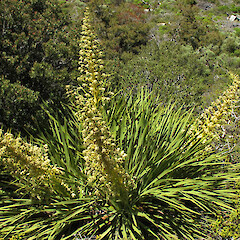Aciphylla horrida
Family
Apiaceae
Flora category
Vascular – Native
Endemic taxon
Yes
Endemic genus
No
Endemic family
No
Structural class
Herbs - Dicotyledons other than Composites
NVS code
The National Vegetation Survey (NVS) Databank is a physical archive and electronic databank containing records of over 94,000 vegetation survey plots - including data from over 19,000 permanent plots. NVS maintains a standard set of species code abbreviations that correspond to standard scientific plant names from the Ngä Tipu o Aotearoa - New Zealand Plants database.
ACIHOR
Chromosome number
2n = 22
Current conservation status
The conservation status of all known New Zealand vascular plant taxa at the rank of species and below were reassessed in 2017 using the New Zealand Threat Classification System (NZTCS) – more information about this can be found on the NZTCS website. This report includes a statistical summary and brief notes on changes since 2012 and replaces all previous NZTCS lists for vascular plants.
Please note, threat classifications are often suggested by authors when publications fall between NZTCS assessment periods – an interim threat classification status has not been assessed by the NZTCS panel.
- Conservation status of New Zealand indigenous vascular plants, 2017 . 2018. Peter J. de Lange, Jeremy R. Rolfe, John W. Barkla, Shannel P. Courtney, Paul D. Champion, Leon R. Perrie, Sarah M. Beadel, Kerry A. Ford, Ilse Breitwieser, Ines Schönberger, Rowan Hindmarsh-Walls, Peter B. Heenan and Kate Ladley. Department of Conservation. Source: NZTCS and licensed by DOC for reuse under the Creative Commons Attribution 4.0 International licence.
2017 | Not Threatened
Previous conservation statuses
2012 | Not Threatened
2009 | Not Threatened
2004 | Not Threatened
Distribution
Endemic. South Island, from Mount Uriah south, in higher rainfall areas favouring the western side of Southern Alps, more common towards the south.
Habitat
Sub-alpine to Low-alpine (600-1400 m.a.s.l.) often common in mixed snow tussock-scrub and snow tussock-herbfield.
Detailed description
A massive bright green plant growing up to 1 m tall, as single clumps or in small groups. Leaves pinnate 2-3 pairs, up to approximately 80 cm long; sheaths thick and coriaceous, approximately 50 mm wide at base, narrowing to 30 mm; stipules simple, about (100)-150-(250) mm long, pungent. Petioles thick, coriaceous, ribbed; margins cartilaginous, serrulate; internodes short. Primary pinnae up to approximately 40 cm x 2-(3) cm, very coriaceous, finely striate, midrib obscure, usually strongly curved, lanceolate, margins serrulate, apex pungent. Flowering stems approximately 150 cm tall, stout, strongly grooved, flowering through most of their length, inflorescence broad. Bracts numerous, the lower empty, or with ill-developed umbels. Bract-sheath approximately 55 x 35 mm; stipules up to 75 x 7 mm, distinctly ribbed; lamina simple, lanceolate, up to approximately 185 x 15 mm, narrowing from widest part about ⅔ way. Umbels roughly equal to bract-sheaths; rays numerous, up to 30 mm long. Umbellules of male plants on long slender rays, of females on shorter rays. Involucral bracts lanceolate. Fruit approximately 4 mm long, mericarps with 2 or 3 broad wings.
Similar taxa
Aciphylla ferox the leaves have a long (100-150 mm) petiole with only upper half of the leaf being divided, in A. horrida the leaf almost divides from base.
Also see taxonomic notes below.
Flowering
November - January
Fruiting
December - February
Life cycle
Winged schizocarps are dispersed primarily by wind (Thorsen et al., 2009).
Etymology
aciphylla: From the Latin acicula ‘needle’ and the Greek phyllum ‘leaf’, meaning needle-leaf.
horrida: Prickly or bristly
TAXONOMIC NOTES
Dawson & LeComte suggest this species is part of the group with milky juice. They note is also seen to hybridise; A. horrida x A. similis Temple Basin, = A. latibracteata (therefore dismissing this species level recognition) reported by J. W. Dawson.
An entity known as Aciphylla “Lomondi” is also similar to this species, “it is found in the dryer eastern areas (Livingstone Mts, Eyre Mts, Wakatipu Basin). It can be difficult distinguishing it from A. aurea where the two species meet. Generally, the leaf segments are wider and often but not always glaucous (Lyttle, pers. comm. 2021)”.
Attribution
Description adapted by M. Ward from Allan (1961) and Mark (2012).
References and further reading
Allan, H. H. 1961. Flora of New Zealand. Vol. 1. Wellington: Government Printer. pg. 486.
Dawson, J.W. LeComte, J.R. 1978. Research on Aciphylla - a progress report. Tuatara 23: pg. 49-67.
Lyttle, D. 2021. Personal communication on InaturalistNZ January 17th, 2021. https://inaturalist.nz/observations/68189913
Mark, A. F. 2012. Above the Treeline: A Nature Guide to Alpine New Zealand. Craig Potton Publishing, Nelson. pg. 138.
Thorsen, M. J.; Dickinson, K. J. M.; Seddon, P. J. 2009. Seed dispersal systems in the New Zealand flora. Perspectives in Plant Ecology, Evolution and Systematics 2009 Vol. 11 No. 4 pp. 285-309










